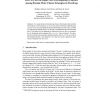Free Online Productivity Tools
i2Speak
i2Symbol
i2OCR
iTex2Img
iWeb2Print
iWeb2Shot
i2Type
iPdf2Split
iPdf2Merge
i2Bopomofo
i2Arabic
i2Style
i2Image
i2PDF
iLatex2Rtf
Sci2ools
SAB
2010
Springer
2010
Springer
How to Pick the Right One: Investigating Tradeoffs among Female Mate Choice Strategies in Treefrogs
Two main theories of female mate choice, that females either pick the best from the n closest males (best-of-n) or the closest with some minimum quality (min-threshold), make different behavioral predictions in some cases, yet both are supported by biological data. We present a computational agent-based model that is well-suited for investigating the differences between the two strategies for the biological model organism Hyla versicolor (“gray treefrog”). We show, based on results from systematic simulation studies, that min-threshold overall is the dominant strategy, even though best-of-n has some areas in parameter space where it dominates min-threshold. Key words: female choice, mating strategies, agent-based modeling
Computational Agent-based Model | Female Mate Choice | Optimization | Organism Hyla Versicolor | SAB 2010 |
| Added | 30 Jan 2011 |
| Updated | 30 Jan 2011 |
| Type | Journal |
| Year | 2010 |
| Where | SAB |
| Authors | Matthias Scheutz, Jack Harris, Sunny K. Boyd |
Comments (0)

